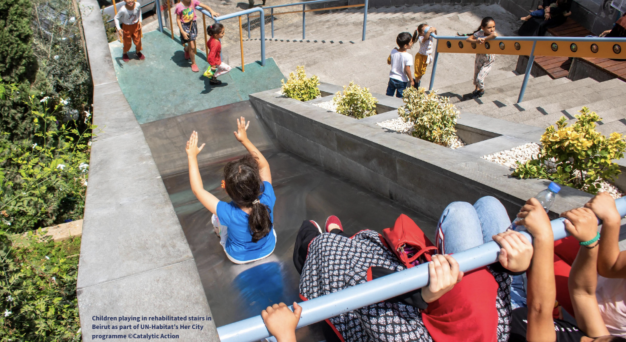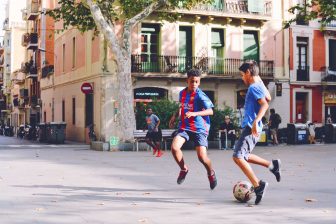
Making public spaces better for children: a new blog series
Public spaces are crucial for children’s holistic development and wellbeing. A new blog series showcases how public spaces can be made better for children. Using global examples from Cities4Children members and other initiatives, the aim is to spotlight ideas for action, innovation, programmes, policies and practice that make public spaces child friendly.
Why are public spaces important for children?
Investments in public spaces for children can have far-reaching benefits. Safe, accessible and inclusive public spaces increase children’s access to play, creativity, socialising and learning opportunities – and are vital for their physical, mental, social and emotional development and wellbeing. In public spaces, children also participate in civic and community life and learn about local cultures, traditions and diversity, says the Urban Hub Team at Save the Children International.
Better public spaces also make cities more liveable and improve quality of life for everyone. They increase the resilience of cities and their residents to climate change impacts, foster social cohesion and boost local economies. They can transform car-dominated streets into walkable, people-friendly spaces and renature cities. In addition, making public spaces like roads safer for girls also increases their access to education, skills and employment. It also reduces gender-based violence and increases women’s active participation in civic life and local and global economies.
Why cities need better and more equitable public spaces
The Charter of Public Space defines public space as ‘all places publicly owned or of public use, accessible and enjoyable by all for free and without profit motive.’[i] UN-Habitat recommends that for cities to be healthy and liveable, they need 45–50 per cent of urban land to be allocated to streets and open public spaces. UN-Habitat categorises public spaces as:
- Public open spaces such as parks, gardens, playgrounds, public beaches, riverbanks and waterfronts
- Streets such as avenues and boulevards, squares and plazas, pavements, passages and galleries, bicycle paths, sidewalks, traffic islands, tramways and roundabouts, and
- Public facilities such as public libraries, civic/community centres, public toilets and public sports facilities.
The Sustainable Development Goals (SDGs) also emphasise the vital importance of developing public open spaces. SDG Target 11.7 is to:
Provide universal access to safe, inclusive and accessible, green and public spaces, in particular for women and children, older persons and persons with disabilities.
However, the 2023 report on progress towards the SDGs shows that three-quarters of the cities in the 120 countries that reported data on SDG Target 11.7 have only 20 per cent of urban land allocated to public spaces: less than half the recommended amount. And on average, most public spaces in the sampled cities are car-dominated streets, with only 3.2 per cent of urban land dedicated to public open spaces.
In addition, the distribution of and access to public spaces is often highly inequitable, with poorer and informal residents having the least access. But when common spaces in informal settlements are developed through strong partnerships between local communities, governments and built environment practitioners, they can result in multifunctional, well-managed and productive spaces with multiple benefits for children and youth.
Showcasing initiatives to make public spaces better for children
In this first blog of the series, we showcase five initiatives supported by Cities4Children Alliance member organisations around the world that give a flavour of what our members are doing to improve public spaces for children.
UN-Habitat, Global Designing Cities Initiative, Arup, BYCS and the Van Leer Foundation have each been supporting cities to conceive public spaces for children that go beyond parks and playgrounds, using a child lens. Their programmes and tools have enabled local authorities, communities and organisations in cities to rethink and remake public spaces such as roads, parks, playgrounds, markets, city plazas, public stairways and public transport nodes in ways that benefit children.
Arup
Arup is a global collective of designers, consultants and experts dedicated to sustainable development. Arup supports public space initiatives in cities in high-income and low- and middle-income countries. These range from a 16-kilometre community greenway in Belfast to an 11-acre child-friendly waterfront park in Long Island City, New York, to child-centred resilience building in informal settlements in Salvador, Brazil.
Arup has also developed several publications that offer tools, guidance and ideas for action for making public spaces in cities child friendly:
- Cities alive: designing for urban childhoods
- Playful cities design guide: play for anyone, anywhere
- Proximity of care design guide
- Nature-based play

Arup’s Nature-based Play publication offers local authorities, built-environment practitioners, and communities several ideas for action for fostering the connections between nature and play in cities.
BYCS
BYCS is an Amsterdam-based global NGO supporting community-led urban change through cycling around the world:
- In Dublin, Lisbon and Rome, their Bicycle Heroes initiative (featured in this blog) gives children a platform to make their cities safer and more fun to cycle in, by designing and implementing new ideas in partnership with key decision makers.
- In Latin American cities, Cycling Mobilities of Care (featured in this blog) addresses specific barriers to cycling (such as access and skills) faced by children and parents to increase cycling among these key groups.
- The Bicycle Mayor Network supports and connects over 140 ‘bicycle mayors’ in 34 countries (individuals who represent cycling progress and the interests of their communities). A global initiative, the Bicycle Major Network aims to amplify the impact of bicycle mayors in expanding cycling in their cities, especially among women and children.

BYCS supports cycling initiatives for young children in Quito, Ecuador © Amanda Padilla – Bicycle Mayor of Quito, Ecuador
Global Designing Cities Initiative
Global Designing Cities Initiative supports local authorities in cities across the globe to make child-friendly street transformations. The Streets for Kids programme works with urban designers, local communities and city officials to apply child-focused strategies found in the Designing Streets for Kids guide through streetscape transformations, workshops and training. You can learn more about their work in this Cities4Children blog.

Children playing in the reclaimed and redesigned street spaces © GDCI
UN-Habitat’s Global Public Space Programme
UN-Habitat’s Global Public Space Programme (GPSP) has been active for over 10 years. The programme aims to inspire global and local action at scale for creating safe, inclusive and sustainable public spaces, especially for the most vulnerable urban residents such as low-income communities, girls and women, and children. The initiative has supported over 145 public space interventions in 55 countries and provides technical support and capacity building through learning events, toolkits and guidance.

Children playing in rehabilitated stairs in Beirut as part of UN-Habitat’s Her City programme © Catalytic Action
Van Leer Foundation
The Van Leer Foundation’s Urban95 initiative is driven by a key question: if you could experience the city from 95cm – the height of a healthy three-year-old child – what would you change? The initiative supports city officials, urban planners and designers with learning, toolkits and guidance to shape cities that are responsive to the needs of young children and their caregivers. It funds catalytic initiatives to improve public spaces and mobility for children and caregivers, to improve young children’s access to nature, and build capacity for family-friendly urban planning and design. You can read more about the initiative in our blog featuring the Urban95 initiative.

A child enjoying a child-friendly community space created through the Urban95 initiative in Lima, Peru © Reinier van Oorsouw/Bernard van Leer Foundation
About the Cities4Children blog series on public space for children
In this new series, we curate existing Cities4Children blogs while also producing new content. We aim to spotlight ideas for action, innovations, programmes, policies and practice which make public spaces child friendly.
If you’d like to follow the series, you can keep up to date by signing up to our regular mailing list or reading our Cities4Children blog online. You can also share examples of good practice and policies from your own cities and towns by getting in touch with us here.
This blog was written by the Urban Hub Team at Save the Children International with cooperation from Cities4Children member organisations featured in this blog – Arup, BYCS, Global Designing Cities Initiative, UN-Habitat and Van Leer Foundation. Special thanks to Dr Sudeshna Chatterjee for reviewing the blog and to Holly Ashley for her copy editing services.
This blog was first published by the Global Alliance – Cities4Children (www.cities4children.org/blog) and is republished here under a Creative Commons Attribution-NonCommercial-NoDerivatives 4.0 International License




